|
The Birth of Modernity
|
 |
|
|
It seems as if someone flipped a switch at the turn of the last century - as the calendar
clicked over to the first decade of the 20th century, modernity was born. Every aspect of
human endeavor underwent unprecedented change - art, science, social norms, people's attitude
towards the world and what they wanted from it - the Western world started changing at a speed
previously unheard of. If you look at the world as it was in the beginning of the 20th century
and what it was like at the end of it, the transformation is utterly astonishing, it is two
different worlds and this transformation was kick-started in the early 1900's. Of course these changes didn't occur in a vacuum and the history preceding it prepared the way for it to happen, it is simply the scope, speed and extent of the changes that was unprecedented. Some historians would say modernity started during the Renaissance in the 1500's, others, during the Enlightenment in the 1700's but for me true modernity began in the early 1900's. The preceding history was merely preparing the fertile soil and planting the seeds of the modern Western world's seedlings to burst forth early in the 20th century. And even if all this is a single process, to the observer the difference between seeing the soil and seeing the green vital plant growing from it would seem like two distinctly different things. This modernity is mainly a thing of the mind, essentially a paradigm shift, a change of view or approach to the world because physically most of the material already existed - the industrial world, the machine age has already started some 200 years before, it simply took time for the human psyche to catch up and apply the spirit of it to the metaphysical world as well as to all their other endeavors. Naturally anything this profoundly new will take some time to filter through to the entire society and permeate the collective consciousness, but the forerunners, the intellectual revolutionaries found themselves in the enviable position of having an infinity of possibilities, with everything new yet to be done. The birth of the modern for fine art was pretty much centered in France [with the exception of the Expressionists in Germany] - all the artists ended up in Paris where they were inspired by the French Impressionists from whom they learned that the colours doesn't need to be the somber, dark colours of the old school, that the brush strokes doesn't need to be formal and pedantic. That you can take your subjects outside into the bright sunlight and that they needn't be the staid and pompous rich but ordinary people doing ordinary things. That the final word on realism was said by the invention of the camera earlier in the century and that art can attempt to be something other than copies of reality. Here in Paris they exchanged ideas to create the various movements that became the first truly modern art. Matisse and the Fauves, Braque and Picasso and the Cubists. Some of these painters, notably the two Fauves, Derain and Matisse and the Cubist Picasso, were also the pioneers of modern sculpture, applying the new inventions of their painting to sculpture and with the addition of the groundbreaking work of the sculptor Constantin Brancusi, Modern sculpture was born. Curiously enough, the birth of modern architecture occurred on the other side of the Atlantic, in Chicago, where Frank Lloyd Wright, mostly by himself brought architecture into the new century with his simple yet elegant, flat roofed houses with their strong and unembellished horizontal lines and visible structural concrete. Their departure from any preceding architectural styles was so startling that it took almost ten years before the rest of the Western world followed suit with De Stijl, Bauhaus and the International Style modernist architecture. The bleak existentialist tone, the unembellished, almost journalistic fragments of created reality and broken narrative of Modernist literature paved the way for literature as we know it today, women started seeing the results of a long history of suffrage and Freud transformed the field of psychology. With the emergence of Ragtime and consequently Jazz, modern music entered the world
together with radio broadcasting and motion pictures developed gradually from a carnival
novelty to one of the most important tools of communication, entertainment,
and mass media in the 20th century. Motion picture films, radio and later television have had
a substantial impact on the arts, technology, and politics.
Transport was revolutionized when the Wright brothers built the first successful motorized
aircraft and Henry Ford made motorcars affordable to the masses with the Model T. In 1901 Hubert Booth invents a compact and modern vacuum cleaner, in 1902 Willis Carrier invents the air conditioner and George Claude invents neon light, in 1903 William Coolidge invents ductile tungsten that is used in light bulbs, Mary Anderson invents windshield wipers and Edward Binney and Harold Smith invent crayons - can anyone alive today imagine a childhood without crayons? In 1906 William Kellogg invents cornflakes, in 1908 Jacques Brandenberger invents cellophane and in 1909 G. Washington invents instant coffee. And last but far from least, Albert Einstein, one of the geniuses of the 20th century, not only turned physics on its head with his Theory of Relativity but also philosophy, inspiring relativism, the philosophy that claims that there is no absolute truth or right and wrong. That opposing viewpoints can have equal validity, relative to its historical and cultural frame of reference. |
|
The Birth of Modern Painting
The catalysts: Impressionism and Art nouveau
Just after the middle of the 1800's the Impressionists emerged with a new approach to painting: "art for art's sake" or "pure painting" which asserted the identity of a painting as a created object in its own right with its own structure as opposed to merely being an illusion or imitation of the world. It signified that the brush strokes and colours are beautiful in itself rather than that what it tries to portray or represent. That the canvas is no longer a window to the world but a screen made up of canvas and paint - the viewer must look at a painting, not through it.
The famous Impressionists Monet, Renoir, Degas started painting the shimmering, luminous
colours of the outdoors or in Degas' case, the bright stage lights of the theatre that lit up
his ballerinas. They painted people in outdoor cafés, picnicking, boating, barmaids and
prostitutes and dancers and acrobats in the theatre, the circus, in dance halls and bars, the
prints and screens from Japan with their light infused colours that also inspired their own
palette.
The lights flickered and swayed over their largely urban subjects, the colours blurred in a romantic haze, saturated with the sheer joy of a carefree life, depicting life in which gaiety, charm and good times were idealized, saying that the good life was no longer the prerogative of a limited aristocracy and that even the poorest can participate in it. Ironically, the Impressionists rebelling against the realism of their predecessors, were actually more acute and accurate scientific observers of the prismatic outdoor light and colours than the dark and muddy traditional studio paintings of said predecessors. In this, Impressionism became the final word in the tradition of realistic painting.
In the late 1800's the Art Nouveau movement exemplified another brief but important transition
between the old and the new in the arts. Visually it was the search for an abstraction based
on linear rhythms and the literature was occupied with mystism and symbolism.
Art Nouveau revolted against the academicism of traditional historical styles and instead of constant references to classical periods of Western culture, it drew its inspiration from the medieval, Celtic and Saxon linear interlace of illuminated books, carving and jewellery, from the bold flat patterns of Japanese art and the highly decorative quality of chinoiserie - ceramics and jades and enameled work. This resulted in the recognizable Art Nouveau aesthetic of dynamic linear movement, sinuous, organic lines, naturalistic and semi-abstract pattern, strong botanical and zoological forms and spatial flow, paving the way for the truly modern of the 20th century. The Art Nouveau style and iconography permeated all the arts and art-related industries - graphic design, illustration, textiles, furniture, wallpaper, lamps, glass and ceramics, kitchenware, painting, sculpture and decorative objects, architecture. The most recognizable artists who worked in the Art Nouveau style are Henri Toulouse-Lautrec in France, Gustav Klimt in Austria and William Blake in England who is maybe more known for his poetry, the mysticism that fascinated him evident in both. And who hasn't seen Louis Comfort Tiffany's famous lamps. Then of course, there's Antoni Gaudi in Spain's remarkable architecture, inspired by Gothic, Moorish and North-African architecture and tree forms. Art Nouveau architecture is very sculptural with its free-form walls, curved and angled, merging into ceilings and floors, growing around organic shaped windows. Its undulating roof lines, twisted chimney pots, its iron work growing over balconies like vines, its rooms and corridors flowing into each other to transform architecture into a dynamic space. Art Nouveau was drawn to movement, possibly unconsciously inspired by the machine age, by the very first motor cars, translating this movement back to the natural, to the swirling, growing plant stems, the wavy lines of its architectural and furniture detail, its sculpted animals always in motion, its mythical human forms often winged - think of the Rolls Royce decal for instance. The Art Nouveau writers like Oscar Wilde, Edgar Allen Poe and the French symbolist writers were occupied with romantic visions of evil, the erotic and decadent, all expressed elegantly and decoratively. 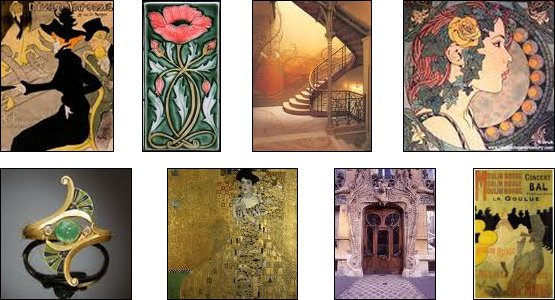
The Birth of Modern Painting
Three stylistically different movements gave birth to modern painting - the Fauves, the Cubists and the Expressionists. They all learnt from the Impressionists and Post-Impressionists that painting can be something other than slavishly copying reality and their different interpretations of this revelation led to the differences in the movements. Their exposure to primitive and especially African art reinforced this notion that there are different ways of interpreting and representing the forms seen in real life, a different visual vernacular.
The Impressionists
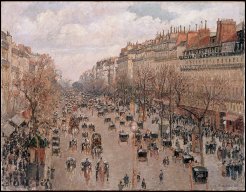

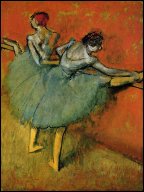
Camille Pisarro: "Boulevard Montmartre" 1897 , Claude Monet: "Woman with a Parasol" 1875 ,
Edgar Degas: "Dancers at the Bar" 1888
The Post-Impressionists
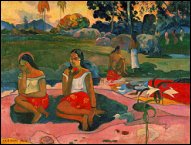
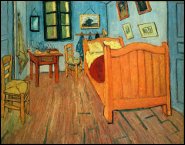
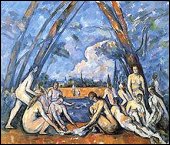
Paul Gaugin: "Sacred Spring" 1894 , Vincent van Gogh: "Bedroom in Arles" 1888 ,
Paul Cezanne: "The Large Bathers" 1898-1905
The Fauves
At their exhibition in 1905 in the Salon d'Automme Henri Matisse and the Fauves astonished and shocked the art world with their vivid colours and spontaneous and violent brush strokes, giving rise to their name, the wild beasts. The Fauves were preoccupied with brilliant, arbitrary colour, colour independent of its appearance in reality, colour for colour's sake. Their images were constructed with these abstract colour shapes and lines and this final liberation of colour is their contribution to modernity.
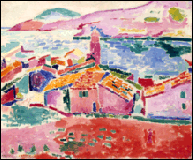
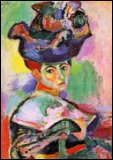
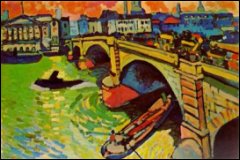
Henri Matisse: "Open Window at Collioure" 1905 , Henri Matisse: "Woman with a Hat" 1905 , Andre Derain: "London Bridge" 1906
Within a few years the Fauves all moved on and each went his own way stylistically.
Matisse, the star and leader of the Fauves, started using bold distortion and flat planes of brilliant colour in his curvaceous and undulating, heavily outlined forms, retaining only the essentials of the plastic form and spatial depth. The rhythmic arrangement of line and colour on a flat plane, the placement of figures or objects in the empty spaces around them and their proportions all played a part in expressing the profound joyousness of the act of painting, the message that he wanted to impart to the viewer in all its freshness and immediacy - the purpose of his pictures is to give pleasure. With his radically simplified tones and drawing and consequently his style, he became the so-called genius of omission, pointing towards the even more elegant and simplified paper cut-outs that he created near the end of his life. 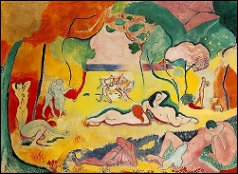
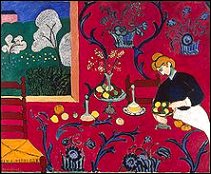

Henri Matisse: "The Joy of Life" 1905-6 , Henri Matisse: "Harmony in Red" 1908 , Henri Matisse: "Zulma" 1950
The Fauves established a precedent for a series of revolutions in the 20th century art that followed, pioneering the abstraction of colour that opened the way for total abstraction later.
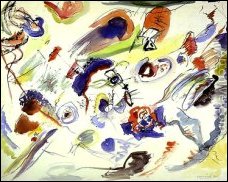
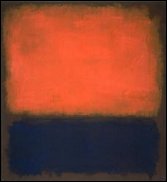

Wassily Kandinsky: "First Abstract Watercolour" 1910 , Mark Rothko: "No. 14" 1960, Joan Miró: "The Gold of the Azure" 1967
The Expressionists
Although Georges Rouault exhibited with the Fauves in 1905, stylistically he wasn't considered a Fauve but rather an expressionist - his paintings were hung in a different room. In his own words he wanted to paint "the passion mirrored upon a human face" with his intense technique.
His work was deeply religious, emotional and profoundly moralistic, portrayed in a literal yet symbolic form. His subjects expressed a strong moral indignation and disgust with the evils of social rot and the prostitute became one of his symbols for this. He depicted her with fierce loathing, painting the heavy outlines with savage, slashing brush strokes, the faces repulsive masks, exuding decay and death to portray his revulsion. Another symbol of the corrupt society was his tragic, lacerated clowns, the colours rich but somber. Later in his religious themes, the glowing colours intensified within the heavy black outlines defining the forms, the paint heavily applied, strongly reminiscent of stained glass [he was trained in youth as a stained glass worker]. The mood was of tragedy and sorrow in the suffering of Christ, but also of calm, hope and salvation. 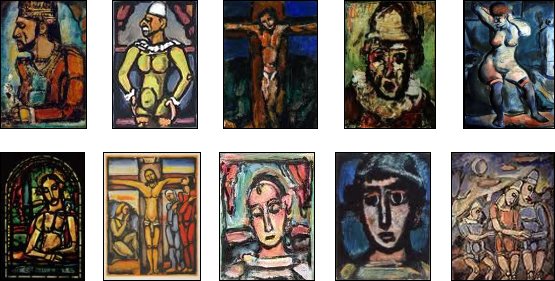
The Norwegian artist Edvard Munch spent 3 weeks in Paris in the late 1900's where he saw the Impressionists' work, developing a specific affinity for Manet. He eventually settled in Germany where he started working with a literary and mystical approach intensified by his own tortured personality. Norwegian literature rose to a new level at the time with the emergence of Henrik Ibsen and many of Munch's paintings referred to Ibsen's plays.
Munch used the Impressionistic palette but the mood was much more melancholy and suggestive of his own inward torment. Spectres of sickness and death occupied him for most of his life and appeared in his work early along with his other themes of violence and sexual awakening. There was a synchronicity in his sexual angst themes with the work of Sigmund Freud who was at the time developing his theories of psychoanalysis and sexual repression. Munch's used a lot of sinuous and agitated brush strokes and colours dark in hue but with brilliant intensity to paint his fear-filled subjects, creating a haunting and disturbing mood, evoking strong emotions of disquiet. 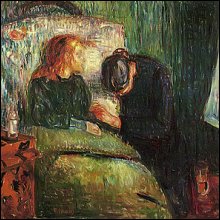

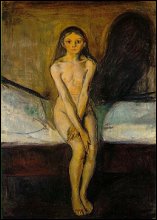
Edvard Munch: "The Sick Child" 1885-6 , "The Cry" 1893, "Puberty" 1894
The paintings of these first expressionists and the expressionists who came after them, expressed strong, passionate and somber emotions, using fierce brush strokes and intense colours with heavy black areas to elicit these same emotions in the viewer. This violent technique and colours was later used to great effect for abstract expressionism paintings as well.
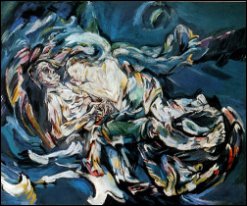
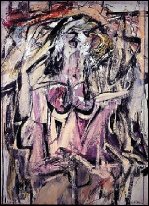

Oskar Kokoschka: "The Bride of the Wind" 1914 , Willem de Kooning "Woman" 1949-50, Jackson Pollock: "No.1 [Lavender Mist]" 1950
The Cubists
The Cubists were mostly inspired by the Post-Impressionist Cezanne as well as African masks and sculptures and its primary subject was the still life that revealed daily life, together with the human figure. Its principle founders, Pablo Picasso and George Braque, started breaking down the sculptural mass of the subject into a series of flat planes or structural units resulting in the facets that is characteristic of the style, creating a system in which the 3rd dimension is stated entirely in terms of flat, slightly tilted planes, organized within a linear grid on or near the surface of the painting. The surface of the paint texture was controlled and directed by the sharp geometry of the linear structure into the accumulation of planes.
They reduced the colours to a minimum, approaching monochrome, to emphasize the design, sticking with tones of greys, greens, browns and ochre with black, later eliminating the greens as well. This was the first or analytical phase of Cubist where the picture plane was broken up into abstract structural components, translating the visual world in a new manner. 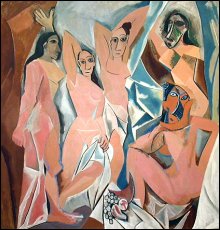
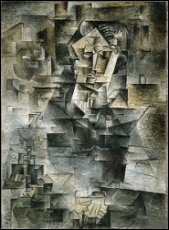
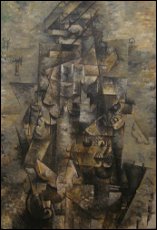
Pablo Picasso: "Les Demoiselle d'Avignon" 1907 , Pablo Picasso: "Daniel-Henry Kahnweiler" 1910, Georges Braque: "Man with a Guitar" 1910
In 1911 they started adding hand-lettered words and collages of paper, rope, newsprint, strips of imitation wood graining, oil cloth with a chair caning motif and other scraps of found material to the picture surface. The picture space gradually ceased to be created by the illusion of painted and modeled facets but instead was built up by the overlapping of actual pasted materials. The fragments became larger with time and they started using more colour, expanding their initial, limited palette. This was the 2nd or collage phase of cubism.
Eventually they stopped using the collage method and simply started to paint to look like collage with even larger fragmented areas and still brighter colours. 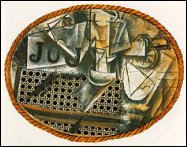
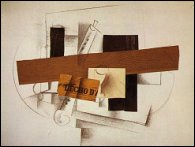
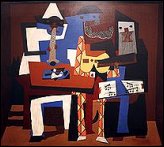
Pablo Picasso: "Still Life with Chair Caning" 1911 , Georges Braque: "The Clarinet" 1913 , Pablo Picasso: "Three Musicians" 1921
Where Fauvism led the way in the abstraction of colour and line, Cubism led the way in the abstraction of the picture plane itself and Expressionism led the way in creating intense emotion with their violent and unrestrained technique.
Together they opened the door to eventual complete abstraction where the beauty and emotion of the painting is derived solely through the beauty and emotion of colour, shape and line. 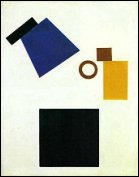
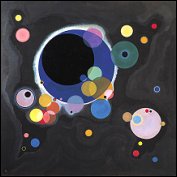
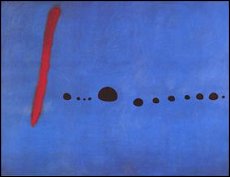
Kasimir Malevich: "Suprematist Self Portrait" 1915 , Wassily Kandinsky: "Several Circles, no.323" 1926 , Joan Miró: "Blue II" 1961
|
|
The Birth of Modern sculpture
Auguste Rodin took the first step in redefining sculpture the same way the Impressionists did for painting at roughly the same time. The surfaces of his earlier work was vigorously creased with welts and wrinkles resulting in an ever-changing pattern of flickering patches of light very much like the Impressionists achieved with their paint. The malleable lumps from which he built up his forms similar to the visible brush strokes of the Impressionist painters and consequently it was also called "unfinished" by the critics, just like their work. Although visually it mirrors the Impressionists, in spirit and subject it was closer to Expressionism in that it often expressed a more somber and melancholy mood of pain and suffering and later on his most daring work, Balzac, was technically also more Expressionist. Gone was the flickering light and instead the surface was roughly modeled in large areas, the elemental force and inner agony of his subject distilled to its most powerful essence.
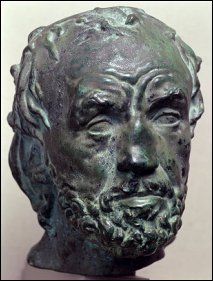
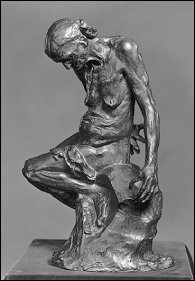

Auguste Rodin: "The Man with the Broken Nose" 1864 , "The Old Courtesan" 1885 , "Balzac" 1897
It is often contended that modern sculpture was created by painters and with the exception
of Brancusi, is seems to be largely the case. Certainly major contributions to sculpture were
made by the painters, applying the discoveries they made in painting to sculpture as well.
In 1907 the Fauve, Andre Derain, carved Crouching Man from a single block of stone,
creating a sculpture startling in its simplicity yet capturing its essence in the large flat
planes perfectly, strongly reminiscent of the primitive sculptures that the modernists adored.
Another Fauve, Henri Matisse, also sculpted pieces of unique quality and invention in the
first decade of the new century. His figures had a harsh primitive quality with their
distorted proportions, the exaggerated differentiation between the anatomical volumes,
reminiscent of the colour areas of his paintings, the "unfinished" surface texture creating a
lively play of light.
With his reliefs, Back I - IV, he progressively eliminated anatomical detail to culminate in near abstraction similar to the progression of his painting over the course of his life.
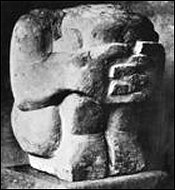
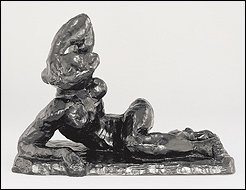
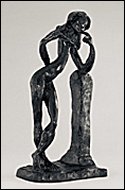
Andre Derain: "Crouching Man" 1907 , Henri Matisse: "Reclining Nude 1" 1907 , Henri Matisse: "La Serpentine" 1909
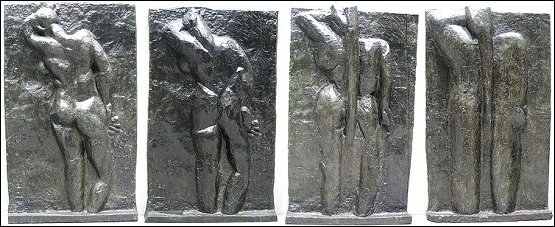
Henri Matisse: "Back I - IV" 1909 - 1910
Picasso applied cubist principles to sculpture as well and with Head of Fernande Olivier, 1909, he created an entirely new kind of sculpture by working the geometry in and out over the surface, creating the first cubist sculpture, a work of great historical significance.
The Rumanian, Constantin Brancusi, went to Paris in 1904 to become the first true sculptor
of modernity and consequently influenced most modern sculptors after him to some degree. He
was interested in the formal simplicity and coherence of primitive sculpture and had the same
genius of omission as Matisse. His "primevalism" was the starting point of a sculptural
tradition that continued into the rest of the century.
In the 2nd decade of the century he created another sculptural first - the first completely non-representational sculpture. A work of uncompromising simplicity, expressing not something tangible but the abstract concept of flight, making it visible and concrete with the most elegant minimalism of form, creating a new continuity between the sculpted volume and the space surrounding it, his ultimate aim to give visual and tactile joy to the viewer. 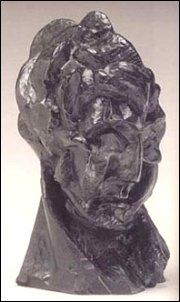
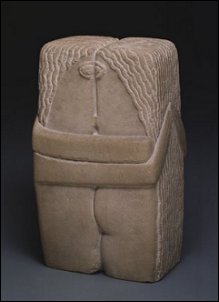

Pablo Picasso: "Head of Fernande Olivier" 1909 , Constantin Brancusi: "The Kiss" 1912 , Constantin Brancusi: "Bird in Space" 1924
|
|
The Birth of Modern Architecture
20th century architecture is rooted in 19th century technology - reinforced concrete, the metal framed construction with the non-weight-bearing masonry and the structural steel skeleton filled in with glass made famous by the Crystal Palace in 1851.
The great fire in Chicago in 1870 opened up large tracts of land and created opportunities for architects to build new and modern buildings. And although these large buildings bore a strong symmetry and lacked the ornamentation of their predecessors, they were still very Romanesque and became merely the forerunners of the true skyscrapers. The skyscrapers as we know them, that became so iconic of the 20th century, were only going to start appearing in the 1930's and 1940's.
The architectural revolution happened at first on the residential building front and the first lone pioneer was Frank LLoyd Wright in Chicago.
For the first decade of the 20th century the modern concepts of utility, of beauty arising from undecorated, interrelated simple shapes, of form that follows function, made his 'Prairie Houses' with their low horizontal lines and their open, free-flowing plans unique in the world. The flat roofs, the strong horizontal and vertical forms, the verandas that accommodated a flow between the interior and exterior spaces revealed the influence of Japanese architecture. The unadorned concrete displayed an honesty of material and they seemed to 'float' on the surface of the ground. His intellectual and perceptive cohesiveness that equaled the European painters of the time made him the only "cubist" architect until 1910 when the German, Adolf Loos, took this new architectural style across the Atlantic.
Adolf Loos, after studying architecture in Dresden, went to America where he learned about the new approach to architecture and when he went back to Germany, he settled in Vienna and built the abstract and rectangular Steiner house in the modern style.
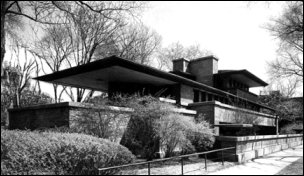
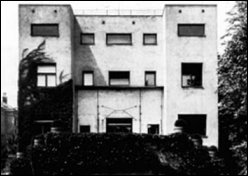
Frank Lloyd Wright: "Robie House" Chicago 1909 , Adolf Loos "Steiner House" Vienna 1910
Walter Gropius followed in 1914 with his Administrative Building and Hall of Machinery for
the Deutsche Werkbund exhibition and eleven years later with the Bauhaus art school in Dessau
with its structural steel facade and its continuous glass surface.
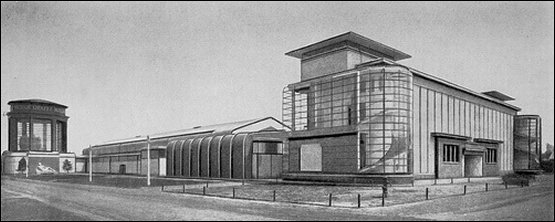
Walter Gropius: "Administrative Building and Hall of Machinery" for the Deutsche Werkbund exhibition in Cologne 1914
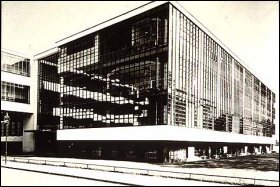

Walter Gropius: Bauhaus Art School, Dessau 1925
Modern architecture now spread across Europe: Dutch architect Robert Van 't Hoff's Huis ter
Heide in 1916 predated the formation of De Stijl movement to which he later belonged along
with Mondrian and other Dutch artists, designers and architects and was almost entirely based
on his observations of Wright's houses in Chicago. Gerrit Rietveld's Schröder house of 1924 in
Utrecht is a good example of De Stijl architecture.
The wave of the new experiment in architecture with its spatial, constructive and functional aesthetic gained momentum in the 1920's and became known as the International Style and brought together innumerable strands of the modernist tradition. Its weightless, hovering rectangles were liberated from the ground by the columns that suspended it and created unique manipulations of space and form.
The 1st principle of the International Style was the elimination of the weight-bearing wall - it became screens of glass, metal or masonry and the result was that windows and doors could distributed freely and be any size or shape and that the open interior could be divided in any way or it could have an open plan. The 2nd principle is the avoidance of applied decoration - beauty resulted from proportions and the distribution of solids and voids, the unique manipulations of space and form. And the 3rd principle was that building in the International Style lent itself to low cost housing and garden cities involving inexpensive, standardized units of construction. Le Corbusier called his houses machines for living in, referring to their clean and precise shapes. His Villa Savoye in Poissy-sur-Seine, 1928, is a famous example of International Style architecture. 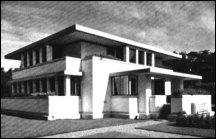

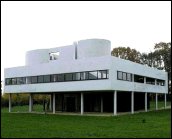
Robert Van 't Hoff: "Huis ter Heide" Utrecht 1916 , Gerrit Rietveld: "Schröder House" 1924 , Le Corbusier: "Villa Savoye" Poissy-sur-Seine
1928
The modern architects often designed the furniture for their houses as well, seeing that the modern furniture they needed didn't exist yet. Mies van der Rohe's Barcelona chair, Gerrit Rietveld's De Stijl desks, chairs and sideboard and Marcel Breuer from the Bauhaus' famous armchair are a few examples.



Mies van der Rohe: "Barcelona chair" , Gerrit Rietveld: "De Stijl chair" , Marcel Breuer: "Wassily chair"
|
|
Modernist and Modern Literature
Modernism as a literary movement reached its height in Europe between 1900 and the middle 1920s. It addressed aesthetic problems similar to those examined in non-literary forms of Modernist art, such as Modernist painting. Gertrude Stein's abstract writings, for example, have often been compared to the fragmentary and multi-perspectival Cubism of her friend Pablo Picasso and as a literary movement is seen, in large part, as a reaction to the emergence of city life as a central force in society.
Modernistic literature normally revolved around the idea of individualism, mistrust of institutions (government, religion), and the disbelief of any absolute truths. Stylistically it moved away from Romanticism, often featuring a marked pessimism and rejecting the optimism apparent in Victorian literature and examining subject matter that is traditionally mundane. Where Romanticism stressed the subjectivity of experience, Modernist writers were more acutely conscious of the objectivity of their surroundings, a shift from a knowledge-based aesthetic to a being-based aesthetic. This shift is central to Modernism.
The Modernists eschewed straight forward narrative, instead they built up each story through an accumulation of finely observed, seemingly inconsequential moments and with this, transformed writing. Almost every serious writer today adopts this approach to some extent, including writers of popular genres and escapist literature.
Other stylistic characteristics are: free indirect speech, stream of consciousness, wide use of classical allusions (like the use of Ulysses' myth in Ulysses by James Joyce), quotation, pun, satire, irony, unconventional use of metaphor, symbolic representation, psychoanalysis, discontinuous narrative and multiple narrative points of view.
Modernist literature is an opening up of the world in all of its forms - theoretically, philosophically, aesthetically, and politically. Before Modernism, the world was thought of in a Realist's fashion - an image in reading of which projects the world in an objective fashion.
Modernist Literature departed from Realism with a concern for larger factors such as social or
historical change by introducing concepts like disjointed timelines and stream of
consciousness writing, taking the reader into a world of unfamiliarity, a deep introspection,
a cognitive thought-provoking experience, skepticism of religion, and openness to culture,
technology and innovation.
The general thematic concerns of Modernist literature are well-summarized by the sociologist Georg Simmel:
"The deepest problems of modern life derive from the claim of the individual to preserve the autonomy and individuality of his existence in the face of overwhelming social forces, of historical heritage, of external culture, and of the technique of life." The Modernist re-contextualization of the individual within the fabric of this received social heritage can be seen in the "mythic method" which T.S. Eliot expounded in his discussion of James Joyce's Ulysses: "In using the myth, in manipulating a continuous parallel between contemporaneity and antiquity, Mr. Joyce is pursuing a method which others must pursue after him ... It is simply a way of controlling, of ordering, of giving a shape and a significance to the immense panorama of futility and anarchy which is contemporary history."
Darwin's work, which theorizes the challenge against traditional Christian views, as God as creator, and in a more natural selective universe, brought an emphasis into Modernistic literature of time travels, questioning ones existence, the purpose of the universe, and a suspicion of God.
Modernist literature consists of the belief in time as cyclical and not chronological, the belief in free will, the cognitive exploration of the subconscious, and the questioning of the universe with and without a God.
Time, in Modernist literature, may take the reader through a day in the life of a narrator; whereas in Realism, the reader is taken into a year in the life of the characters.
Time is viewed as cyclical in that the reader is moved from one image to another in flutters rather than in a start to finish manner - a juxtaposition of events may unfold at once. This belief in a cyclical time also brings about free will and a cognitive exploration of the subconscious because the reader can climb inside the mind, away from the body and feel free to explore the inner working of one's mind and one's subconscious. The Modernist brings about a fascination with the way in which one projects reality within the workings of the mind.
Some other themes of the Modernists are: the breakdown of social norms, despairing individual behaviors in the face of an unmanageable future, spiritual loneliness and alienation, disillusionment, the rejection of history and outdated social systems, objection to traditional thoughts, traditional moralities and religious thoughts and the substitution of a mythical past.
But the questioning spirit of modernism could also be seen, less elegiacally, as part of a necessary search for ways to make sense of a broken world.
Modernism has a strong existentialist tone, originating with Kierkegaard who placed the emphasis on an individual existence, of subjectivity and individual freedom and choice. The individual decides on questions of morality and truth for himself, chooses his own path and accepts the risks and responsibility of his actions. Nietzsche said that each individual must choose a goal and follow it with passionate conviction, aware of the certainty of death and the ultimate meaninglessness of one's life.
Much later Sartre would add: humans should stop wasting time puzzling over the curiosity of their own existence and just accept it as a fact and that each human is the architect of his own self, character and destiny.
Here's how it goes: a philosopher thinks up a philosophy, the intellectual, high-brow writers take up with it and incorporate it in their work, writers of popular genres incorporate a more accessible version of it in their work and so it filters down to the larger populace and becomes part of the zeitgeist.
The fatalistic certainty of death and ultimate meaninglessness of life mostly stayed with the Modernists but the idea of individual freedom and choice of a person's own destiny and pursuing it with passion part has become entrenched in the modern psyche and is seen as a given, a right.
Modernist authors include: James Joyce, T. S. Eliot, Gertrude Stein, H.D., Virginia Woolf, Marcel Proust, Dylan Thomas, Ezra Pound, William Faulkner, Rainer Maria Rilke, Franz Kafka, Joseph Conrad, W. B. Yeats, Katherine Mansfield, Samuel Beckett, Robert Frost, Boris Pasternak.

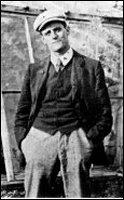


Virginia Woolf, James Joyce, Katherine Mansfield, Franz Kafka
Modern literature
I use the term Modern literature here, as opposed to Modernist literature which is a stylistic movement, as a broader, more generalized term defining literature as we know it today, contemporary literature. [the correct term is actually Post-Modernism, but let's not go there]
Modern literature, though, was born during the 19th century, perhaps the most literary of all centuries, because not only were the forms of novel, short story and magazine serial all in existence side-by-side with theatre and opera, but since film, radio and television did not yet exist, the popularity of the written word and its direct enactment were at its height.
The Romantic movement was well underway and gave rise to genres that readers still enjoy today. There was a romantic tendency toward the exploration of folk traditions and old legends, the gothic novel which had, by this time, come to mean a desire for a romantic return to the times before the renaissance.
In 1807 Charles and Mary Lamb published Tales from Shakespeare, a simple retelling of some of Shakespeare's plays in the form of little stories accessible to a child readership. Along with all the other genres born in the 19th century came the genre of Children's literature.
In 1818 Mary Shelley anonymously published Frankenstein which came to be known, eventually, as the first science fiction novel and the template for the mad scientist subgenre.
In 1819 John Polidori published The Vampyre, the first example of the horror genre.
In the mid-19th century magazines publishing short stories and serials began to be popular. Some of them were more respectable, while others were referred to by the derogatory name of penny dreadfuls
In America a version of the penny dreadful became popularly known as a dime novel. In the dime novels the reputations of gunfighters and other wild west heroes or villains were created or exaggerated thus the western genre came into existence. James Fenimore Cooper began a series of stories featuring the characters Hawkeye and Chingachgook. These stories were not only "westerns" but also historical novels, the earliest setting being approximately 100 years earlier than the year James Fenimore Cooper was writing it.
In 1841 Edgar Allan Poe published a story "The Murders in the Rue Morgue", introducing the fictional detective C. Auguste Dupin, bringing the crime fiction genre into existence.
By the late 1800's the European and North American middle-classes were better educated than ever before and more reading was done. At the same time the styles of writing were tending more and more toward plainer language and more broadly understood themes. People were reading about detectives, ghosts, machines, wonders, adventures, tricky situations, unusual turns of fate and romances. Love stories and grudges, explorations and wars, ideas based on scientific positivism and ideas based on nonsense and gibberish were all being published and enjoyed by a readership which could now be termed "the masses".
Writers and some of their well-known work from the prolific 1800's include:
William Blake, Lord Byron, Goethe [Faust], Jane Austen [Sense and Sensibility, Pride and Prejudice, Mansfield Park, Persuasion ], John Keats, Sir Walter Scott [Rob Roy, Ivanhoe, The City in the Sea], Elizabeth Barrett, Thomas De Quincey [Confessions of an English Opium Eater], Alexandre Dumas [The Three Musketeers, The Count of Monte Cristo], Charles Dickens [The Pickwick Papers, Oliver Twist, Nicholas Nickleby, The Old Curiosity Shop, A Christmas Carol, David Copperfield, Bleak House, Hard Times, Little Dorrit, A Tale of Two Cities, Great Expectations], Anne Brontë [Agnes Grey, The Tenant of Wildfell Hall], Emily Brontë [Wuthering Heights], Charlotte Brontë [Jane Eyre], William Makepeace [Vanity Fair], Dostoyevski [Crime and Punishment, The Idiot, The Brothers Karamazov], Herman Melville [Moby-Dick], Victor Hugo [Les Misérables], Jules Verne [Five Weeks in a Balloon, Journey to the Center of the Earth, From the Earth to the Moon, Twenty Thousand Leagues Under the Sea, Around the World in Eighty Days,], Lewis Carroll [Alice's Adventures in Wonderland, Through the Looking-Glass and what Alice Found There, The Hunting of the Snark], Mark Twain [The Adventures of Tom Sawyer, The Adventures of Huckleberry Finn,], Oscar Wilde [The Canterville Ghost, The Picture of Dorian Gray, Salomé, Lady Windermere's Fan, The Importance of Being Earnest and An Ideal Husband], H. Rider Haggard [King Solomon's Mines, She, The Saga of Eric Brighteyes, an epic viking novel], Sir Arthur Conan Doyle [A Study in Scarlet the first Sherlock Holmes story, The Adventures of Sherlock Holmes, The Memoirs of Sherlock Holmes], H. G. Wells [The Time Machine, The Island of Dr. Moreau, The Invisible Man, The War of the Worlds], Bram Stoker [Dracula], Henry James [The Turn of the Screw].
The early 1900's produced very little memorable modern writing - The Wonderful Wizard of Oz by L. Frank Baum, Kim, Puck of Pook's Hill by Rudyard Kipling, Heart of Darkness by Joseph Conrad, The Immoralist by André Gide, The Wings of the Dove by Henry James, The Hound of the Baskervilles by Arthur Conan Doyle, The Call of the Wild, The Sea Wolf, White Fang by Jack London, Where Angels Fear to Tread and A Room with a View by E. M. Forster, Peter Pan in Kensington Gardens by J. M. Barrie, The Wind in the Willows by Kenneth Grahame and only in the 1920s and 30's there was again a boom of literary creativity, and works of several notable authors appeared during the period.
A few of the most famous being: Siddhartha and Steppenwolf by Hermann Hesse, Passage to India by E. M. Forster, The Great Gatsby by F. Scott Fitzgerald - often described as the epitome of the "Jazz Age", Manhattan Transfer by John Dos Passos, Winnie the Pooh by A. A. Milne, Tropic of Cancer by Henry Miller, Gone with the Wind by Margaret Mitchell, How Green Was My Valley by Richard Llewellyn and works by André Gide, Aldous Huxley, George Orwell, Christopher Isherwood, Lawrence Durrell, Jean-Paul Sartre, Noel Coward, J. R. R. Tolkien and most notably Ernest Hemingway, Graham Greene and John Steinbeck.
Journalism
Another important aspect of the profound social changes of the first decade of the 20th century was the expansion of popular journalism with a new kind of critical writing, enabling a wider dissemination of information, followed and broadened by the growth of radio broadcasting in the next decade.
With the Progressive movement of 'scientific journalism' of the early 1900's, newspapers and magazines were full of exposés and in the quest for increased readership, newspaper editors began to publish sensational headlines and lurid stories. The age of yellow journalism was born where newspapers and magazines reigned as mass media. Journalists were also determined to expose the corruption of government, unfair treatment of factory workers and the privileges of the upperclass. Advertising grew and promoted a culture of consumption - magazines took advantage of advertising to increase their circulation and still keep subscription prices low. General interest and ladies magazines flourished. All these developments marking the birth of modern journalism as we know it today. |
|
Women and Modernity
In the first decade of the 20th century Coco Chanel threw away her corset and started wearing men's trousers or soft unstructured skirts without all the petticoats, combined with simple jerseys and loose-fitting men's shirts, jackets and coats, pre-empting modern women's liberation from restricting and voluminous clothes in the 1920's with the short, unstructured, boxy lines of the flapper dress during the Gatsby era.
By 1909 women started cutting off their cumbersome long hair when bobbed hair became fashion.
Very gradually, after more than a hundred years of suffrage, this decade saw women starting to claim the rights that men had always taken for granted - being the master of their own being, doing what they choose for themselves to do and living as they please, demanding the right to higher education and entry into the professions, humane working conditions, control over their own property, to vote, the right to family planning, to have their voices heard under their own names [women writers often wrote anonymously or under a male nom de plume like Karen Blixen writing as Isak Dinesen or Jane Austen publishing her work anonymously].
In this decade women learned new ways of exploiting the media, creating dramatic graphics and using photography. The battle wasn't done by any means and at the time it was only a small number of women who were the pioneers - the writers and artists, the intellectuals and eccentrics and activists and the women who associated with them, members of the so-called bohemian sub-strata of society.
Only in the following decade it started to spread to the wider community when more women started to attain the vote in various counties and when they entered the labour market in unprecedented numbers and often in new sectors in the absence of large numbers of men during the first World War. They discovered that their work outside the home was now valued.
The Isle of Man was the first free standing jurisdiction to grant women the vote in 1881, followed by New Zealand in 1893, Australian women received the vote at the Federal level in 1902, Finland in 1906, and Norway initially in 1907, completed in 1913, in Denmark and Iceland in 1915 (full in 1919), the USSR in 1917, Austria, Germany and Canada in 1918, and many countries including the Netherlands in 1919, and South Africa in 1930. French women did not receive the vote till 1945. Liechtenstein was one of the last countries, in 1984!
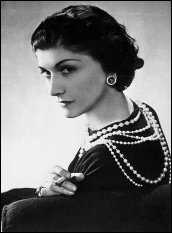
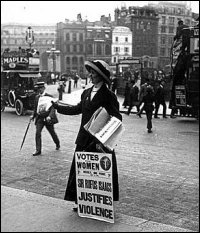
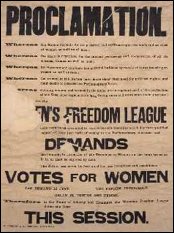
Coco Chanel 1908 , British suffragette 1908 , Women's rights banner
|
|
Sigmund Freud and Modern Psychology
Sigmund Freud was one of the trailblazers of modern-day psychology and pioneered new techniques for understanding human behavior , his efforts resulting in the most comprehensive theory of personality and psychotherapy ever developed.
With the publication of "The Psychopathology of Everyday Life" in 1901, "Three Essays on the Theory of Sexuality" in 1905, "Jokes and their Relation to the Unconscious" in 1905, "Delusion and Dream in Jensen's Gradiva" in 1907, Freud transformed the field of psychology.
As the originator of Psychoanalysis, he is best known for his theories of the unconscious mind and the defense mechanism of repression, and for creating the clinical practice of psychoanalysis for treating psychopathology through dialogue between a patient and a psychoanalyst.
This came to be known as the "talking cure" and the ultimate goal of this talking was to locate and release powerful emotional energy that had initially been rejected or imprisoned in the unconscious mind. Freud called this denial of emotions "repression", and he believed that it was an impediment to the normal functioning of the psyche, even capable of causing physical retardation which he described as "psychosomatic". The goal of Freudian therapy, or psychoanalysis, was to bring repressed thoughts and feelings into consciousness in order to free the patient from suffering repetitive distorted emotions. Classically, the bringing of unconscious thoughts and feelings to consciousness is brought about by encouraging a patient to talk in free association and to talk about dreams. Another important element of psychoanalysis is lesser direct involvement on the part of the analyst, which is meant to encourage the patient to project thoughts and feelings onto the analyst. Through this process, transference, the patient can discover and resolve repressed conflicts, especially childhood conflicts involving parents.
In his "Three Essays on the Theory of Sexuality", Freud hoped to prove that his model was universally valid and thus turned to ancient mythology and contemporary ethnography for comparative material. Freud named his new theory the Oedipus complex after the famous Greek tragedy by Sophocles. "I found in myself a constant love for my mother, and jealousy of my father. I now consider this to be a universal event in childhood," Freud said. Freud sought to anchor this pattern of development in the dynamics of the mind.
He further argued that, as humans develop, they become fixated on different and specific objects through their stages of development-first in the oral stage (exemplified by an infant's pleasure in nursing), then in the anal stage (exemplified by a toddler's pleasure in evacuating his or her bowels), then in the phallic stage. Freud argued that children then passed through a stage in which they fixated on the mother as a sexual object (known as the Oedipus Complex ) but that the child eventually overcame and repressed this desire because of its taboo nature. The repressive or dormant latency stage (6-12 years of age) of psychosexual development preceded the sexually mature genital stage of psychosexual development. Each stage is a progression into adult sexual maturity, characterized by a strong ego and the ability to delay gratification. He used the Oedipus conflict to point out how much he believed that people desire incest and must repress that desire. The Oedipus conflict was described as a state of psychosexual development and awareness. He also turned to anthropological studies of totemism and argued that totemism reflected a ritualized enactment of a tribal Oedipal conflict. Freud's views have sometimes been called phallocentric. This is because, for Freud, the unconscious desires the phallus. Males are afraid of losing their masculinity, symbolized by the phallus, to another male. Females always desire to have a phallus - an unfulfillable desire. Thus boys resent their fathers (fear of castration) and girls desire theirs.
Freud redefined sexual desire as the primary motivational energy of human life, developed therapeutic techniques such as the use of free association, created the theory of transference in the therapeutic relationship, and interpreted dreams as sources of insight into unconscious desires. He was an early neurological researcher into cerebral palsy, and a prolific essayist, drawing on psychoanalysis to contribute to the history, interpretation and critique of culture.
Freud has been influential in two related but distinct ways: he simultaneously developed a
theory of the human mind's organization and internal operations and a theory that human
behavior both conditions and results from how the mind is organized. This led him to favor
certain clinical techniques for trying to help cure mental illness. He theorized that
personality is developed by a person's childhood experiences. In his philosophical writings he
advocated an atheistic world view; he was eulogized as 'the atheist's touchstone' for the
20th century."
While many of Freud's ideas have fallen out of favor or been modified by other analysts, and modern advances in the field of psychology have shown flaws in some of his theories, his work remains influential in clinical approaches, and in the humanities and social sciences. He is considered one of the most prominent thinkers of the first half of the 20th century, in terms of originality and intellectual influence.

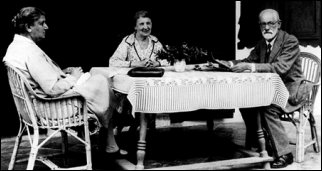
Sigmund Freud
|
|
The Birth of Jazz
The birth of jazz happened with the inception of Ragtime in the musical melting pot of New Orleans. The abolition of slavery led to new opportunities for the freed African Americans and many found work in entertainment.
They fused West African music and blues with European music - light classical music of the late 1800's, John Phillip Sousa-like marches, Irish gigs, German waltzes and the French quadrille into the syncopated rhythms of ragtime. This lively and springy music was ideal for dancing and the name Ragtime is short for ragged time that refers to its rhythmically broken up melodies and the instruments used in marching bands became the basic instruments of ragtime, the drums, brass and reeds.
The black musicians played at dances, minstrel shows and vaudeville for which they formed
marching bands. The brass bands also marched on holidays and at funerals and the pianists
played in bars, clubs and brothels as ragtime developed and spread.
Scott Joplin is considered the foremost composer of ragtime music, combining the rhythmic and melodic music of the black community with European music and many of his compositions, including the famous "Maple Leaf Rag" and "The Entertainer," were published and sold across the country.
Trumpeter Buddy Bolden, one of the prime movers in the origination of jazz, began arranging blues, ragtime and black church music for brass instruments and clarinets, paving the way for early jazz, filling dance halls in New Orleans with audiences eager to hear the "hot" new music.
Best known as a bandleader, King Oliver was also Louis Armstrong’s teacher, and was responsible for launching Armstrong’s career by featuring him in his band. Oliver played with many of the great musicians of early jazz, including Jelly Roll Morton.
Pianist Jelly Roll Morton's music is regarded as a bridge between ragtime and early jazz and in 1906 he wrote the "King Porter Stomp" which is considered the first jazz standard. He helped to bring the style into the limelight by performing rags in bars and brothels in New Orleans and from 1908 he toured the USA, spreading his "hot" music further afield.
Ragtime led to the development of the style known as stride piano, one of the first forms of jazz. The word "stride" comes from the action of the left hand as it strikes a bass note and then moves swiftly up the keyboard to strike chord tones on every other beat.
Growing up listening to Scott Joplin’s rags, James P. Johnson was one of the originators of the stride piano style. His music, which used most of the conventions of ragtime, also included improvisation and elements of the blues, two aspects that were widely influential in the development of jazz. The music of Fats Waller, Duke Ellington, and Thelonious Monk is due in large part to the innovations of James P. Johnson.
Early jazz, often referred to as Hot Jazz and sometimes Dixieland music incorporated the fast and spirited nature of ragtime and the use of trumpets, trombones, saxophones, clarinets, banjos and either a bass or a tuba. Hot jazz and stride pianists often toured the USA in vaudeville shows and inspired more bands to be formed as jazz became more and more popular and were soon filling the airwaves and dance halls and led to the swing era.
From jazz in turn developed rock and roll, the notable music genre of the 20th century, as well as rhythm and blues, reggae, bop and ska.

Scott Joplin, The Bolden Band, Jelly Roll Morton
|
|
The Birth of Modern Radio Broadcasting
In 1900 Reginald Fessenden made a weak radio transmission of voice, Guglielmo Marconi patented tuned circuits for wireless transmission - this enabled a wireless to be tuned to a particular frequency, to remove all other transmissions except the one of interest and in 1901, Marconi conducted the first successful transatlantic experimental radio communications.
These breakthroughs were enabled by the work done late in the previous century - by Heinrich Hertz, the first person to intentionally transmit and receive radio as predicted by Maxwell's equations, by Nikola Tesla who developed means to reliably produce radio frequencies, publicly demonstrated the principles of radio and transmitted long distant signals and Alexander Popov, who was the first to develop a practical communication system based on the coherer.
The invention of amplitude-modulated (AM) radio, so that more than one station can send
signals, is attributed to Reginald Fessenden, who on Christmas Eve 1906, made the first radio
audio broadcast, from Brant Rock, Massachusetts. Ships at sea heard a broadcast that included
Fessenden playing O Holy Night on the violin and reading a passage from the Bible.
In 1907, Marconi established the first commercial transatlantic radio communications service, between Clifden, Ireland and Glace Bay, Newfoundland and in April 1909 Charles David Herrold, in San Jose, California constructed a broadcasting station.
It used spark gap technology, but modulated the carrier frequency with the human voice, and later music. Herrold, the son of a farmer, coined the terms "narrowcasting" and "broadcasting", respectively to identify transmissions destined for a single receiver such as that on board a ship, and those transmissions destined for a general audience. (The term "broadcasting" had been used in farming to define the tossing of seed in all directions.) Charles Herrold did not claim to be the first to transmit the human voice, but he claimed to be the first to conduct "broadcasting". To help the radio signal to spread in all directions, he designed some omnidirectional antennas , which he mounted on the rooftops of various buildings in San Jose. Herrold also claims to be the first broadcaster to accept advertising (he exchanged publicity for a local record store for records to play on his station). 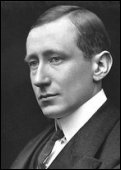
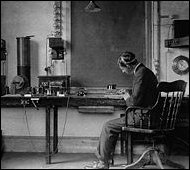
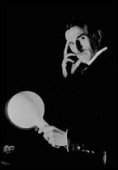
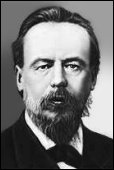
Guglielmo Marconi, Donald Manson, an employee of the Marconi Company, Nikola Tesla, Alexander Popov
|
|
The Birth of Modern Cinema
Roundhay Garden Scene, filmed by Louis Le Prince on October 14, 1888 in West Yorkshire is now known as the earliest surviving motion picture.
On June 21, 1889, William Friese-Greene was issued patent no. 10131 for his 'chronophotographic' camera. It was apparently capable of taking up to ten photographs per second using perforated celluloid film. Friese-Greene gave a public demonstration in 1890 but the low frame rate combined with the device's apparent unreliability failed to make an impression.
Many researchers in the late 19th century realized that films as they are known today were a practical possibility, but the first to design a fully successful apparatus was W. K. L. Dickson, working under the direction of Thomas Alva Edison. His fully developed camera, called the Kinetograph, was patented in 1891 and took a series of instantaneous photographs on standard Eastman Kodak photographic emulsion coated on to a transparent celluloid strip 35 mm wide. The results of this work were first shown in public in 1893, using the viewing apparatus also designed by Dickson, and called the Kinetoscope, a cabinet in which a continuous loop of Dickson's celluloid film (powered by an electric motor) was back lit by an incandescent lamp and seen through a magnifying lens. The spectator viewed the image through an eye piece. This was contained within a large box, and only permitted the images to be viewed by one person at a time looking into it through a peephole, after starting the machine by inserting a coin. Kinetoscope parlours were supplied with fifty-foot film snippets photographed by Dickson, These sequences recorded mundane events (such as Fred Ott's Sneeze, 1894) as well as entertainment acts like acrobats, music hall performers and boxing demonstrations.
Charles Francis Jenkins had the idea of displaying moving pictures for group audiences, rather than just to individual viewers, and invented a film projector, the Phantoscope, giving his first public showing, and the earliest documented projection of a motion picture, in 1894.
It was not a commercial success in this form, and left the way free for the Lumière brothers, Louis and Auguste, to perfect their apparatus, the Cinématographe in 1895, a portable, three-in-one device: camera, printer, and projector. This was the first successful projector, as well as being the apparatus that took and printed the film beforehand. With their Cinématographe they gave the first show of projected pictures to an audience in Paris in December 1895 and father Antoine Lumière began exhibitions of projected films before the paying public, beginning the general conversion of the medium to projection. The movies of the time were seen mostly via temporary storefront spaces and traveling exhibitors or as acts in vaudeville programs. A film could be under a minute long and would usually present a single scene, authentic or staged, of everyday life, a public event, a sporting event or slapstick. From 1900 Charles Pathé began film production under the Pathé-Frères brand and by 1905, Pathé was the largest film company in the world, a position it retained until World War I.
"The Nickelodeon" opened in Pittsburgh in 1905 and with the first successful permanent theatre showing nothing but films all day long, the era of modern cinema was brought into being. By this date there were finally enough films several minutes long available to fill a programme running for at least half an hour, and which could be changed weekly when the local audience became bored with it. Other exhibitors in the United States quickly followed suit, and within a couple of years there were thousands of these nickelodeons in operation. The American situation led to a worldwide boom in the production and exhibition of films from 1906 onwards.
By 1906, the cinema had moved from a novelty to an established large-scale entertainment industry. The films themselves progressed from films consisting of one shot, completely made by one person with a few assistants, towards films several minutes long consisting of several shots.
With the worldwide film boom, yet more countries now joined Britain, France, and the United States in serious film production. In 1907 there were about 4000 small "nickelodeon" cinemas in the United States and by 1908, 8000. The films were shown with the accompaniment of music provided by a pianist or there could be more musicians. By the end of 1907, however, the nickelodeon boom began to decline, and entrepreneurs began to build movie theaters with greater seating capacities where larger audiences could see longer film programs.
Intertitles containing lines of dialogue began to be used consistently from 1908 onwards.
In that year, Vitagraph's "An Auto Heroine", or, "The Race for the Vitagraph Cup and How It
Was Won", contains a couple of dialogue titles, and the same firm's "Julius Caesar" includes three lines of dialogue from Shakespeare's play quoted in intertitles before the actors speak them, finishing with "This was the noblest Roman of them all". From 1909 a small number of American films, and even one or two European ones, came to include a few dialogue titles, or "spoken titles" as they were called at the time.
In most countries the need for spoken accompaniment quickly faded, with dialogue and narration presented in intertitles, but in Japanese cinema it remained popular throughout the silent era. The introduction of dialogue titles was far from being a trivial matter, for they entirely transformed the nature of film narrative. When dialogue titles came to be always cut into a scene just after a character starts speaking, and then left with a cut to the character just before they finish speaking, then one had something that was effectively the equivalent of a present-day sound film.
In the silent era of film, marrying the image with synchronous sound was not possible for inventors and producers, since no practical method was devised until 1923, thus, for the first thirty years of their history, movies were silent.

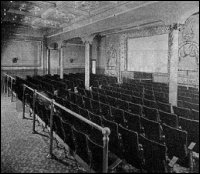
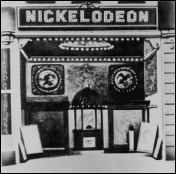
Still from "A Trip to the Moon" , Interior of the first Nickelodeon, Exterior of a Nickelodeon
Animation
The first animation was created in 1899, with the production of the short film "Matches: An Appeal", a thirty-second long stop-motion animated piece intended to encourage the audience to send matches to British troops fighting the Boer War. The relative sophistication of this piece was not followed up for some time, with subsequent works in animation being limited to short, two or three frame effects, such as appeared in Edwin Porter's 1902 short "Fun in a Bakery Shop", where a lump of dough was made to smile over the course of a three-frame sequence.
Works rivaling the British short in length did not appear until 1905, when Edwin Porter
made "How Jones Lost His Roll", and "The Whole Dam Family and the Dam Dog". Both of these films
had intertitles which were formed by the letters moving into place from a random scattering to form the words of the titles.
In 1906, Albert Edward Smith and James Stuart Blackton at Vitagraph took the next step,
and in their "Humorous Phases of Funny Faces", what appear to be cartoon drawings of people move
from one pose to another. This is done for most of the length of this film by moving jointed
cut-outs of the figures frame by frame between the exposures, just as Porter moved his letters. However, there is a very short section of the film where things are made to appear to move by altering the drawings themselves from frame to frame, which is how standard animated cartoons have since been made up to today.
The technique of single frame animation was further developed in 1907 by Edwin S. Porter
in "The Teddy Bears" and by J. Stuart Blackton with "Work Made Easy".
In the first of these the toy bears were made to move, apparently on their own, and in the latter film building tools were made to perform construction tasks without human intervention, by using frame-by-frame animation. The technique got to Europe almost immediately, and Segundo de Chomon and others at Pathé took it further, adding clay animation, in which sculptures were deformed from one thing into another thing frame by frame in "Sculpture Moderne" (1908), and then Pathé made the next step to the animation of silhouette shapes. Also in France, Emile Cohl fully developed drawn animation in a series of films starting with "Fantasmagorie" (1908), in which humans and objects drawn as outline figures went though a series of remarkable interactions and transformations. |
|
The Kodak Brownie and Colour film
By 1900 still cameras have already been invented but they were large and ungainly as well as expensive and the use of photographic film has already being pioneered by George Eastman, who started manufacturing paper film in 1885 before switching to celluloid in 1889.
His first camera, which he called the "Kodak," was first offered for sale in 1888. It was a very simple box camera with a fixed-focus lens and single shutter speed, which along with its relatively low price appealed to the average consumer. The Kodak came pre-loaded with enough film for 100 exposures and needed to be sent back to the factory for processing and reloading when the roll was finished. By the end of the 19th century Eastman had expanded his lineup to several models including both box and folding cameras.
In 1900, Eastman took mass-market photography one step further with the Brownie, a simple and very inexpensive box camera that introduced the concept of the snapshot. The Brownie was extremely popular and various models remained on sale until the 1960s.
In 1907 August and Louis Lumiere invented colour photography, pioneering photography as we know it today.
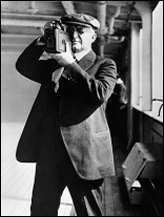


George Eastman , Kodak No.2 Brownie box camera , Auguste & Louis Lumière
|
|
The Birth of Aviation
In 1899, after Wilbur Wright had written a letter of request to the Smithsonian Institution for information about flight experiments, the Wright Brothers designed their first aircraft: a small, biplane glider flown as a kite to test their solution for controlling the craft by wing warping. Wing warping is a method of arching the wingtips slightly to control the aircraft's rolling motion and balance.
The Wright Brothers spent a great deal of time observing birds in flight. They noticed that birds soared into the wind and that the air flowing over the curved surface of their wings created lift. Birds change the shape of their wings to turn and maneuver. They believed that they could use this technique to obtain roll control by warping, or changing the shape, of a portion of the wing.
Over the next three years, Wilbur and his brother Orville would design a series of gliders which would be flown in both unmanned (as kites) and piloted flights. They read about the works of Cayley, and Langley, and the hang-gliding flights of Otto Lilienthal. They corresponded with Octave Chanute concerning some of their ideas. They recognized that control of the flying aircraft would be the most crucial and hardest problem to solve.
Following a successful glider test, the Wrights built and tested a full-size glider. They selected Kitty Hawk, North Carolina as their test site because of its wind, sand, hilly terrain and remote location.
In 1900, the Wrights successfully tested their new 50-pound biplane glider with its 17-foot wingspan and wing-warping mechanism at Kitty Hawk, in both unmanned and piloted flights. In fact, it was the first piloted glider. Based upon the results, the Wright Brothers planned to refine the controls and landing gear, and build a bigger glider.
In 1901, at Kill Devil Hills, North Carolina, the Wright Brothers flew the largest glider ever flown, with a 22-foot wingspan, a weight of nearly 100 pounds and skids for landing. However, many problems occurred: the wings did not have enough lifting power; forward elevator was not effective in controlling the pitch, and the wing-warping mechanism occasionally caused the airplane to spin out of control. In their disappointment, they predicted that man will probably not fly in their lifetime.
In spite of the problems with their last attempts at flight, the Wrights reviewed their test results and determined that the calculations they had used were not reliable. They decided to build a wind tunnel to test a variety of wing shapes and their effect on lift. Based upon these tests, the inventors had a greater understanding of how an airfoil (wing) works and could calculate with greater accuracy how well a particular wing design would fly. They planned to design a new glider with a 32-foot wingspan and a tail to help stabilize it.
During 1902, the brothers flew numerous test glides using their new glider. Their studies showed that a movable tail would help balance the craft and the Wright Brothers connected a movable tail to the wing-warping wires to coordinate turns. With successful glides to verify their wind tunnel tests, the inventors planned to build a powered aircraft.
After months of studying how propellers work, the Wright Brothers designed a motor and a new aircraft sturdy enough to accommodate the motor's weight and vibrations. The craft weighed 700 pounds and came to be known as the Flyer.
The brothers built a movable track to help launch the Flyer. This downhill track would help the aircraft gain enough airspeed to fly. After two attempts to fly this machine, one of which resulted in a minor crash, Orville Wright took the Flyer for a 12-second, sustained flight on December 17, 1903. This was the first successful, powered, piloted flight in history.
In 1904, the first flight lasting more than five minutes took place on November 9. The Flyer II was flown by Wilbur Wright.
Since May 14, 1908, the Wright Brothers allowed passengers to fly with and in 1909, the U.S. Government bought its first airplane, a Wright Brothers biplane, on July 30.

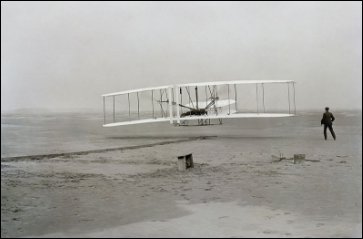
Orville & Wilbur Wright , First flight
|
|
The Model T Ford and Mass Production
Although motor cars have been in use for some years by the dawn of the 20th century, with the founding of Ford Motor Company in 1903 and the sale of the first Model T in 1908, the modern age of motoring has arrived. With the production of the Model T, cars became affordable to the masses whereas before only the wealthy could afford cars.
The Ford company wanted to scale up production in keeping with Henry Ford's vision of a car designed and manufactured on a scale so as to be affordable by the average worker. In Henry Ford's own words: "I will build a car for the great multitude".
The solution that Ford Motor developed was a completely redesigned factory with special purpose machine tools that were systematically positioned in the work sequence and Ford used machines, thoughtfully arranged, wherever possible to substitute for labor. All unnecessary human motions were eliminated by placing all work and tools within easy reach, and where practical on conveyors, forming the assembly line, the complete process being called mass production.
This was the first time in history when a large, complex product consisting of 5000 parts had been produced on a scale of hundreds of thousands per year. The savings from mass production methods allowed the price of the Model T to decline from $950 in 1908 to $360 in 1916, eventually as low as $280 . Nearly 15 500 000 were sold in the United States alone, heralding the beginning of the Motor Age. Ford's contribution to mass production was synthetic in nature, collating and improving upon existing methods of sequential production and applying electric power to them, resulting in extremely-high-throughput, continuous-flow mass production, making the Model T affordable and, as such, an instant hit. 


Ford assembly line , Henry Ford , Model T
Electrification enabled modern mass production even though household electrification did not become common until the 1920s, and then only in cities. Mass production of assemblies typically uses electric-motor-powered moving tracks or conveyor belts to move partially complete products to workers, who perform simple repetitive tasks.
The biggest impact of early mass production was in manufacturing everyday items, such as at the Ball Brothers Glass Manufacturing Company, which electrified its mason jar plant in Muncie, Ohio, USA around 1900.
Mass production allowed the evolution of consumerism by lowering the unit cost of many goods and improved productivity, which was a contributing factor to economic growth and the decline in work week hours, which in turn provided the working class with more free time, creating a market for leisure activities like watching movies and reading newspapers and magazines.
The wide-ranging social impact of mass production included this remaking of the working class as new technologies appeared and created a larger, increasingly professional, middle class, the decline of child labor; and the dramatic growth of a consumer-based, material culture. For the first time in history the working class could afford a wide range of items to make their lives more comfortable and pleasant. For the first time the working class could afford the new.
Mass production was later extended to industrial design by the Bauhaus and others to provide modern, well designed household items like furniture, lamps, carpets, etc. at affordable prices.
As the new technology was too hard for young people to handle, there was a sharp drop in the demand for workers under age 16. This resulted in a dramatic expansion of the high school system.
Other factors such as the development of transportation infrastructures (canals, railroads and highways) and agricultural mechanization to which Benjamin Holt contributed by inventing the tractor in 1904, enabled the mass production and easier distribution of food.
Another contribution to mass production and industrial design was the invention of Bakelite, the first synthetic plastic, by Leo Baekeland in 1907.
Bakelite was used for its electrically nonconductive and heat-resistant properties in radio and telephone casings and electrical insulators, and also in such diverse products as kitchenware, jewellery, pipe stems, and children's toys, saxophone mouthpieces, whistles, cameras, rotary-dial telephones, clocks and radios. Bakelite is still used today in small precision-shaped components where their specific properties are required, such as molded disc brake cylinders, saucepan handles, electrical plugs and switches and parts for electrical irons as well as for board and tabletop games such as billiard balls, dominoes, Mahjongg tiles and other gaming tilesets, and movers/pieces for games like chess, checkers, and backgammon for the look, durability, fine polish, weight, and sound of the resulting pieces. |
|
Einstein, Modern physics and Philosophy
In 1905 Albert Einstein wrote a paper, "On the Electrodynamics of Moving Bodies", that revolutionized physics and the way we think about the physical world, superseding Isaac Newton's 200-year-old theory of mechanics.
It overturned the concept of motion from Newton's day, stating that all motion is relative. Time was no longer uniform and absolute, as related to everyday experience. Furthermore, no longer could physics be understood as space by itself, and time by itself. Instead, an added dimension had to be taken into account with curved space-time. Time now depended on velocity, and contraction became a fundamental consequence at appropriate speeds.
In the field of particle physics, special relativity catalyzed and added an essential depth of knowledge to the science of elementary particles and their interactions and their fundamental interactions, along with introducing the nuclear age.
The theory of special relativity rapidly became a notable and necessary tool for theorists and experimentalists in the new fields of atomic physics, nuclear physics, and quantum mechanics.
Special relativity is based on two postulates which are contradictory in classical mechanics:
1. The laws of physics are the same for all observers in uniform motion relative to one another (principle of relativity). 2. The speed of light in a vacuum is the same for all observers, regardless of their relative motion or of the motion of the source of the light
Special relativity is a theory of the structure of space-time and has many surprising consequences. Some of these are:
1. Relativity of simultaneity: Two events, simultaneous for one observer, may not be simultaneous for another observer if the observers are in relative motion.
2. Time dilation: Moving clocks are measured to tick more slowly than an observer's "stationary" clock. 3. Length contraction: Objects are measured to be shortened in the direction that they are moving with respect to the observer. 4. Mass-energy equivalence: E = mc² - energy and mass are equivalent and transmutable. 5. Maximum speed is finite: No physical object or message or field line can travel faster than light. 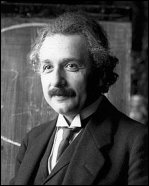
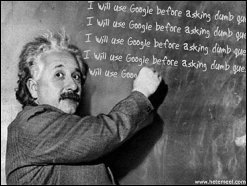
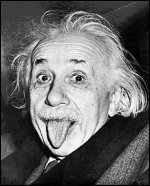
Albert Einstein
Relativism
Einstein is often heralded as the most influential thinker of the 20th century and possibly in modern history, who changed his world in ways that he could not have foreseen. Not only for practical applications such as construction of the atomic bomb or applications to nuclear energy production or synchronization of the global positioning system satellites around the earth but also the implications of relativity as a concept beyond science, its impact on daily life, philosophy, and society. His theories of relativity were used by philosophers, politicians, and activists to turn moral philosophy upside-down.
Relativity fueled postmodernism and philosophic relativism. Prior to relativity, philosophers such as Aristotle, Kant, and Mill argued that there was an absolute truth and an absolute way of approaching various aspects of life. Now with relativity, facts are no longer absolute, but instead dependent upon your viewpoint, your own "philosophical" reference frame. Right and wrong now vary from person-to-person, an idea which meant that each one of our viewpoints could be considered valid as there was no absolute truth or validity. That there is only relative, subjective values according to differences in perception and consideration, due to some particular frame of reference, such as a language or a culture or cognitive bias.
Relativism is sometimes (though not always) interpreted as saying that all points of view are equally valid and that no framework or standpoint is uniquely privileged over any others.
Conceptual relativism is the view that different groups with very different cultures may have rather different conceptions of the world.
Groups of people from different historical times, cultures as well as different individuals perceive the world differently and are influenced by different beliefs, expectations, hopes, desires, aesthetic standards, emotions, personality structure, memory, strategies for problem solving, motivation, decision making, social cognition, sense of humour, language, innate cognitive architecture, scientific frameworks, religion, gender and social status. No-one ever looks at the world with pristine eyes - he sees it edited by a definite set of customs and institutions and ways of thinking that shapes his experience and behaviour.
For example, modern western cultures view individualism, autonomy, persona dignity as key values, other groups see group solidarity or placating the gods as more important. One group may view meekness, humility, submissiveness to the group as virtues and another emphasizes heroism and pride. Such differences in moral concepts, values and practices give rise to different moral perceptions and sensibilities.
An example of historical difference is that the belief that all people are of equal moral worth is central to some people now, but wasn't central to many in ancient Sparta. |
| HOME | WEB DESIGN PORTFOLIO | wilna@daisyworld.co.za | Daisyworld | The Birth of Modernity | The Jazz Era |